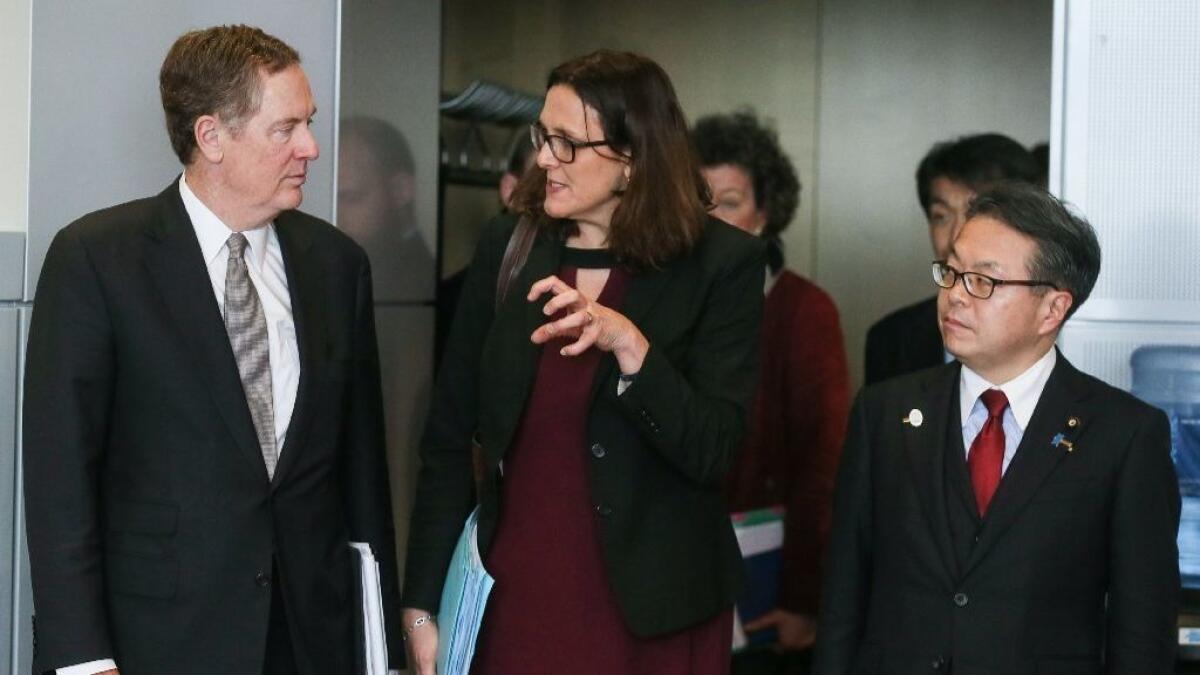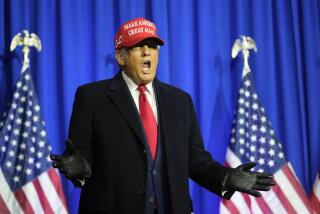How Trump’s tariffs on metals could blow apart the international trade order

By justifying sweeping tariffs on imported metals in the name of national security, President Trump has lobbed what could be a grenade into the global trading order.
For decades that order has been underpinned by the World Trade Organization, whose 164 member-states have agreed to abide by WTO rules for open trade and settling disputes. The United States has been the Switzerland-based group’s chief architect in establishing the principles and procedures governing international trade.
Yet the Trump administration has repeatedly upbraided the organization as slow and incapable of resolving problems, like China’s mercantilist behavior. Moreover, unhappy with the outcome of many WTO decisions, the United States has blocked appointments of judges to fill vacancies, rendering the appellate body largely ineffective.
Now the president is playing the national security card — and some fear that could do serious damage to the multilateral trading system, even blow it up by encouraging other countries to use the same rationale to bypass WTO rules, or give Trump an excuse to back out of the group altogether.
“It is putting a lot of pressure on the WTO in a very sort of existential way,” said Jennifer Hillman, a Georgetown law professor and former WTO appellate body member.
The Trump administration justified the tariffs — 25% on foreign steel and 10% on aluminum — on the basis that imported metals presented a threat to the country’s ability to domestically produce what is needed for the military, invoking a rarely used national security provision of a 1962 U.S. trade law.
Some are skeptical about that threat. Despite a rise in imports, U.S. mills still churn out much more than what’s needed for the military. “There’s enough [domestic] steel and aluminum for the ships, the armored vehicles, the aircrafts that we build,” said Nayantara Hensel, former chief economist for the U.S. Navy.
What’s more, trade statistics show that much of the imported steel and aluminum comes from Canada, Germany and other allies in Europe and Asia that have military agreements with the United States.
That was part of the thinking underlying the Bush administration’s finding that steel imports, which in 2001 also were weighing on U.S. producers, did not pose a threat to national security. But the Trump administration took a broad interpretation of “national security,” arguing that ensuring sufficient domestic supplies of steel and aluminum is critical not just for national defense but also for economic security, which includes U.S. infrastructure like transportation networks, electric power grid and water systems.
“You don’t have steel, you don’t have a country,” Trump said in issuing the tariff orders on March 8.
So far, Trump has exempted just Canada and Mexico from the metals tariffs, and only conditionally. Others have begun negotiating with the administration about how they also might avoid the hit, although it’s still not clear what the criteria are for excluding certain countries or products from the duties. At least some trading partners are likely to contest the tariffs with the WTO. The duties are set to take effect March 23.
The question is, what can, or will, the WTO do about it?
Trade lawyers say the Trump administration’s metals tariffs are illegal under the WTO. The United States didn’t first negotiate through the Geneva-based organization, as required. And in granting exemptions to some countries, the administration has violated a cardinal rule of giving equal treatment in trade.
But there is an escape clause.
According to one of the WTO’s articles adopted from the earlier General Agreement on Tariffs and Trade, a member nation can break the rules of trade and take actions that it “considers necessary for the protection of its essential security interests.” This provision, Article 21, doesn’t specify what those interests are, or who determines them. And there is little precedent on the matter. Recently the United Arab Emirates cited Article 21 in defending its sanctions against Qatar, which has protested UAE’s actions to the WTO.
What is striking, said Georgetown’s Hillman, is that the Trump administration has taken the position that once Article 21 is invoked, that instantly removes the WTO’s authority to settle the dispute. In other words, the national security determination under Article 21 is both self-made and final, in the administration’s view.
“This is the first time you’ve seen that really strong sort of absolute line in the sand of the moment it’s invoked — the case stops,” Hillman said during a recent conference sponsored by the Atlantic Council. “What I don’t know yet, and nobody knows yet, is whether the rest of the members of the WTO are willing to go along with that.”
If the WTO agrees with the U.S. position, many worry that other countries will raise tariffs or erect trade barriers under the same banner of national security,which could ultimately undercut the foundation of the WTO.
But if the WTO decides to take up a case like the U.S. metal tariffs, speculation is rife that the United States could simply walk away from the WTO. Some even see the Trump administration’s reliance on national security as a pretext to withdraw from the multilateral system.
Trump could have chosen a different route to protect steel and aluminum manufacturers, whether giving them grants or turning to the more common trade remedy of levying “global safeguard” tariffs to stem the tide of imports. That is what Trump did earlier this year on imported solar panels and washing machines. Previous administrations have slapped safeguard tariffs on imported tires, socks, motorcycles, as well as steel, in 2002 under President Bush.
But to apply safeguard tariffs, the independent U.S. International Trade Commission has to find that increased imports caused or threaten to cause serious injury to the domestic industry. And it’s not clear the commission would have come to that conclusion on steel.
Last year the three largest U.S.-based steel makers were all profitable, helped by a stronger global economy and higher steel prices. The largest, Charlotte, N.C.-based Nucor Corp., reported a profit of $1.4 billion on a 25% jump in sales to $20 billion.
Dean Pinkert, a trade lawyer and former International Trade Commission member, pointed to another reason Trump may have gone with the national security justification: Unlike global safeguard tariffs, which are limited to four years, duties based on national security can last indefinitely.
Trump, in fact, said in first announcing the steel and aluminum measures that they will be for an “unlimited period … a long period of time.”
The WTO’s head, Roberto Azevedo, has raised concerns about the new U.S. tariffs and urged restraint from all parties, worried about tit-for-tat retaliation. “The potential for escalation is real, as we have seen from the initial responses of others,” he said.
Azevedo later defended the WTO, saying at a forum in Brazil this week that “if it weren’t for the WTO, we would already been in a trade war.”
Ricardo Melendez-Ortiz, chief executive of the International Center for Trade and Sustainable Development in Geneva, said the situation is “very daunting,’ but doesn’t believe the metals tariffs are the death knell for the WTO.
Rather, he hopes that the American actions will lead to reforms in the WTO and the multilateral system. “I don’t think personally that the U.S. and all the interests, whether political or on the business side, would be in support for the U.S. to withdraw from the WTO,” he said. “Because it will basically mean any country can impose barriers to trade on the U.S. … The global economy is integrated in such a way that you would be shooting yourself in the foot.”
Follow me at @dleelatimes






